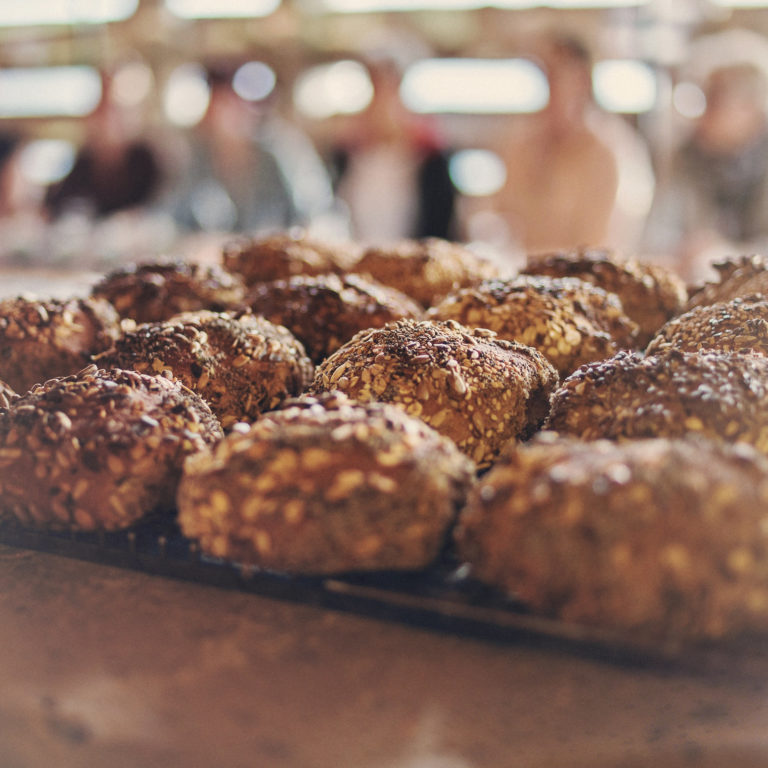
C Paulinarium - Brotbacken am Ludescherberg © Markus Gmeiner / Vorarlberg Tourismus GmbH
The smell of fresh bread
Pauline Burtscher is a baker out of passion

C Paulinarium - Brotbacken am Ludescherberg © Markus Gmeiner / Vorarlberg Tourismus GmbH
Pauline Burtscher is a baker out of passion
Brandnertal · Alpenstadt Bludenz · Klostertal · Großes Walsertal
High above Ludesch, on the “Terrace of Walgau”, stands the 360-year-old Walserhaus that is owned by Pauline Burtscher and her husband Reinhard. This is the place where she kneads and shapes bread – and she’ll teach the traditional craft to anyone who wants to learn it.
TEXT: ANNE SCHÜSSLER
The fire in the oven crackles quietly. The wood hisses and snaps, the embers glow red and orange. Grey smoke streams from the chimney into the white snow-covered winter landscape. The warmth and smell of freshly baked bread hit Pauline as she opens the oven’s cast-iron door. “Nothing is as good as this smell,” the passionate baker says. “My mother always baked bread. And the memories never left me.” She and her husband bought the old, enchanted house built from timber in the Walser style along with the stables on the Ludescherberg in 2001. The building’s dark wooden door with wrought-iron handle and old-fashioned bell that visitors must ring instead of an electric one makes it look a little like a little witch’s cottage. “Yes, I’m a big fan of fairy tales,” says Pauline laughing. She particularly likes the figure of Mother Hulda.
There’s a girl in that fairy tale who has an encounter with a bread oven from which she hears the loaves shouting: “Oh, get me out, get me out, otherwise I’ll burn! I was ready ages ago!” Pauline was so taken with these lines that she had a wood-burning oven built in her garden. She regularly bakes her bread creations in it. “I never have a recipe,” she says, “a little bit of this and a little bit that – it’ll be all right.” She only weighs the ingredients for visitors who take her bread-baking courses so that they can recreate the same breads at home. The trained cook sources her grain from local farmers. She doesn’t have a favourite type of flour. “I use all kinds: spelt, wheat, rye, barley, oats and even buckwheat – the main thing is that it has to be very high quality. I prefer it when I know the farmer personally.”
Good bread takes time.
Her most important rule for baking? “Good bread takes time.” People never had much in the past so they baked lots of bread with just a little bit of yeast. That worked because they gave the dough time. “Today people use a lot of yeast to make the dough rise faster. But it also means that the bread will spoil faster.” It’s precisely this philosophy of bread-baking that Pauline tries to convey to the people attending her courses. But it’s not always about bread. If they’re interested, Pauline’s friends will also show visitors how to weave baskets or take them out on walks to discover the world of herbs.
She holds her courses in the old stables, which today have been converted into a place where she can teach: the Paulinarium. It was extensively renovated and glazed on the interior to preserve the original look. “I definitely wanted to reintegrate the old wood,” says Pauline, “old buildings have a soul. Preserving the old is the real art,” she believes. “Anybody can do new.”
Old buildings have a soul. Preserving them is the real art.
Pauline’s courses are not only about baking bread, not even when she’s kneading dough. She also wants visitors to feel at ease up here. “I want them to forget the stress of their everyday lives and focus entirely on shaping and kneading,” says Pauline. She simply loves what she’s doing: “I’ve only very rarely bought any bread over the last 17 years.”
Cooking und baking in Vorarlberg